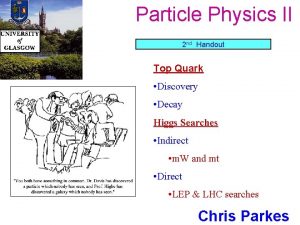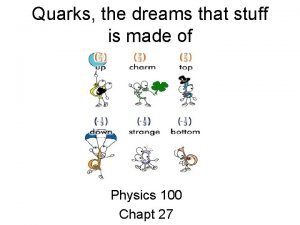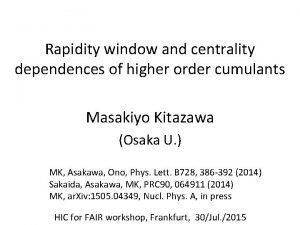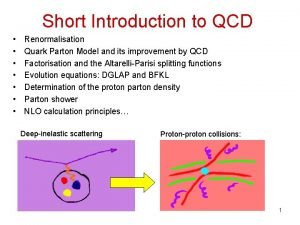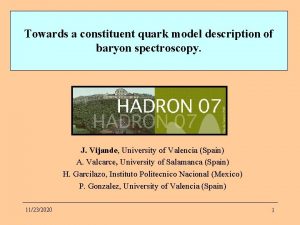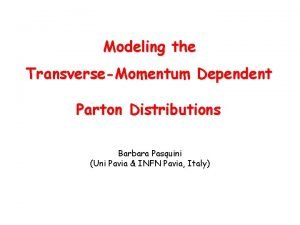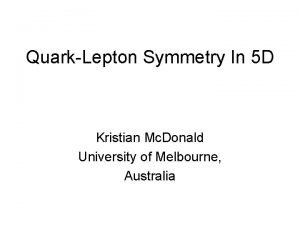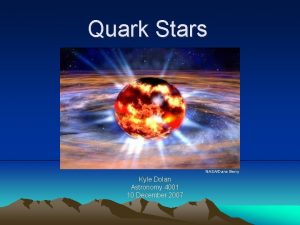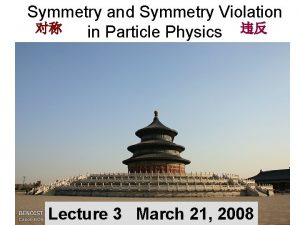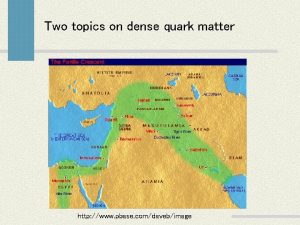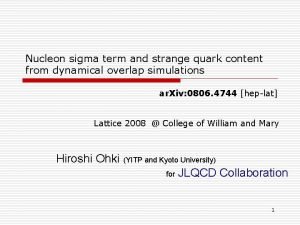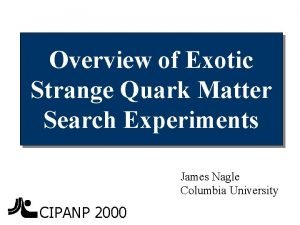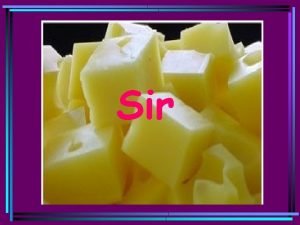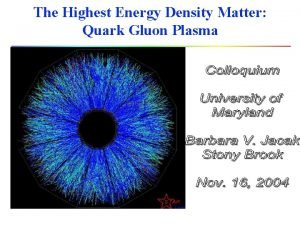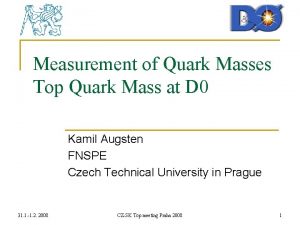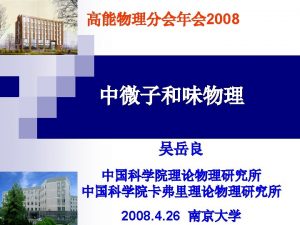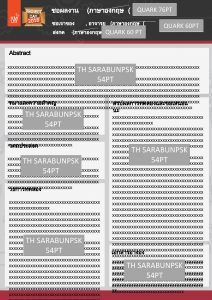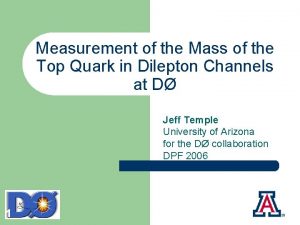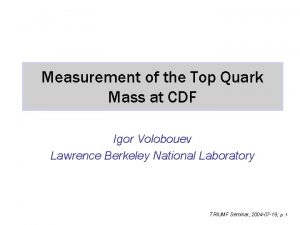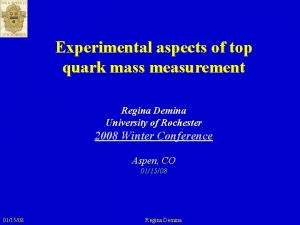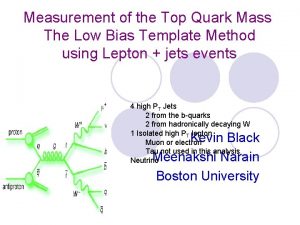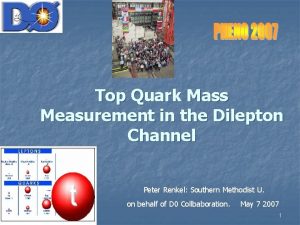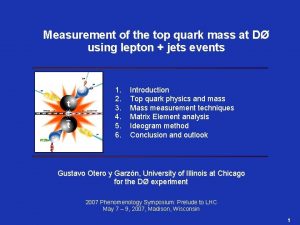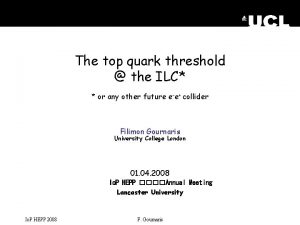Measurement of the Top Quark Mass at D
















![Systematic Uncertainties Run. IIa Source Run. IIb s(m. T) [Ge. V/c 2] Source s(m. Systematic Uncertainties Run. IIa Source Run. IIb s(m. T) [Ge. V/c 2] Source s(m.](https://slidetodoc.com/presentation_image_h2/7cec6a9be1d780cdc173a010e028702c/image-17.jpg)

- Slides: 18

Measurement of the Top Quark Mass at DØ using lepton + jets events using the Matrix Element Method 1. Top quark physics and mass 2. Matrix Element analysis 3. Conclusion and outlook Gustavo Otero y Garzón, Fermilab for the DØ Experiment 2008 Phenomenology Symposium: LHC Turn On April 28 – 30, 2008, Madison, Wisconsin 1

Top Quark CV § Discovered in 1995 by DØ and CDF after a 2 decades hunt and only produced at the Tevatron so far § Heaviest fundamental particle (mt = 172. 6 ± 1. 4 Ge. V) § Strongest coupling to the Higgs (Yukawa coupling lt mt ~ 1) § § may help identify the EWSB mechanism and mass generation may serve as a window to new physics related to EWSB that might couple preferentially to top § A unique laboratory: lifetime (5 x 10 -25 s) shorter than the hadronization time makes it decay as a free quark § We still have a lot to learn about this particle Indirect constraints from low energy data and statistically limited Tevatron data leave plenty of room for new physics § Even if the top is “just a normal quark”, precision top measurements are stringent tests of the SM § 2

Top Quark Pair Production and Decay § Top quarks are mainly produced in pairs (strong interactions) @ 2 Te. V 85% sinel / sttbar ~ 1010 • High luminosity • High efficiency 15% § § § No hadronic bound state due to short lifetime Electroweak decay |Vtb|~1 Final state determined by the decay of the W boson § § § dilepton channel: small background but low rate lepton + jets channel (moderate bkg and a Branching fraction of 1/3) all hadronic channel (largest BF but huge bkg) Lepton≡ e, m from W or from t from W 3

The top quark mass Fundamental parameter of the Standard Model § Affects predictions of SM via radiative corrections mt can be related, with MW, to the Higgs mass dm. W mt 2, ln(m. H) Probing the EWSB mechanism 4

Challenges of this measurement Top quark physics exercises the understanding of all detector components § It is a rare process with significant backgrounds § Jets and MET are observed in the detector, not quarks or neutrinos § m, e, jets (light/b), MET, PV, tracks Run IIb With increased statistics the focus is now on systematics § § § Run IIa In situ calibration of the Jet Energy Scale using W mass in top decays b-jets identification (b-tagging) can be used to reduce physics backgrounds Many systematic uncertainties expected to decrease with larger data samples 5

The Lepton + Jets Channel signal Background W ( l ) + 4 jets QCD Multijet ● fake isolated lepton ● misreconstructed MET 1 isolated high p. T lepton (µ, e) ● 1 (reconstructed as missing transverse energy (MET)) ● = 4 high p central jets T ● 6

The Matrix Element method - I Dynamical method pioneered by DØ yielding the most precise results Maximal use of information in each event by calculating event-by-event probabilities to be signal or background based on the respective matrix elements. Based on all the parton level information “y” the probability to be signal or background would be just proportional to the differential cross section, but… lepton MET jets Differential Cross Section based on LO Matrix Element Transfer function: probability to measure x when parton-level y is produced normalization Initial state Overall JES constrained in situ by MWhadronic Measurements x: jets, MET and leptons 7

The Matrix Element method - II Each jet-to-parton assignment is weighted with b-tagging event probabilities Six particle final state (24 possible weighted assignments between jets and partons) All events are combined in a likelihood… …which is maximized as a function of mtop and JES 8

The Matrix Element method - III The method is calibrated for shifts in mean and uncertainties using ensemble testing in simulated MC events at different top masses and JES From these, functions are determined to calibrate the data 9

Result Using 0. 9 fb-1 of Run. IIa data: Mtop = 170. 5 ± 2. 5 (stat+JES) ± 1. 4 (syst) Ge. V Using 1. 2 fb-1 of Run. IIb data: Mtop = 173. 0 ± 1. 9 (stat+JES) ± 1. 0 (syst) Ge. V Combined Run. II: Mtop = 172. 2 ± 1. 1 (stat) ± 1. 6 (syst) Ge. V 10

Summary: it is heavy! 11

Back up slides 12

Outlook § Improved measurements allows us to reach a 1. 1% precision at DØ • § aim at < 1% with 8 fb-1 The precise measurement of the top mass helps constrain the mass of the SM Higgs and it is one of the most important measurements at the Tevatron 13

The Tevatron Collider § § § Proton-antiproton collider with s=1. 96 Te. V 36 x 36 bunches with 396 ns between crossings 3 ~ collisions per bunch crossing Linst > 1 x 1032 cm-2 s-1 Expected 4 -8 fb-1 integrated luminosity for Run. II (0. 11 fb-1 in Run. I) Right here, right now p `p 1. 96 Te. V Booster CDF P DØ Tevatron `p `p source Main Injector & Recycler Run IIb Run IIa 14

DØ Detector + three tiered trigger system (Event rate reduction from 1. 7 MHz to 50 Hz, 200 k. B/event) 15

Signal Fractions 16
![Systematic Uncertainties Run IIa Source Run IIb sm T Ge Vc 2 Source sm Systematic Uncertainties Run. IIa Source Run. IIb s(m. T) [Ge. V/c 2] Source s(m.](https://slidetodoc.com/presentation_image_h2/7cec6a9be1d780cdc173a010e028702c/image-17.jpg)
Systematic Uncertainties Run. IIa Source Run. IIb s(m. T) [Ge. V/c 2] Source s(m. T) [Ge. V/c 2] Signal modeling ± 0. 98 Relative b / light JES ± 0. 82 Relative b / light JES ± 0. 71 Signal modeling ± 0. 40 Background modeling ± 0. 47 Jet energy resolution ± 0. 30 PDF uncertainty + 0. 26 – 0. 40 PDF uncertainty ± 0. 24 Multijet background ± 0. 16 Multijet background ± 0. 20 Signal fraction ± 0. 15 b-tagging efficiency ± 0. 16 b fragmentation ± 0. 14 MC calibration ± 0. 14 Residual JES uncertainty ± 0. 14 b-fragmentation ± 0. 10 Trigger efficiency ± 0. 08 Trigger efficiency ± 0. 09 b / c semileptonic decays + 0. 06 – 0. 07 Background modeling ± 0. 08 MC calibration ± 0. 06 W heavy flavor factor ± 0. 07 TOTAL ± 1. 40 Residual JES uncertainty ± 0. 03 TOTAL ± 1. 00 17

Run. IIa Result Using 0. 9 fb-1 of Run. IIa data: Mtop = 170. 5 ± 2. 5 (stat+JES) ± 1. 4 (syst) Ge. V 18
 Top quark decay
Top quark decay Quark names
Quark names Quark names
Quark names Quark types
Quark types Quark gluon plasma
Quark gluon plasma Quark parton model
Quark parton model Constituent quark model
Constituent quark model Quark model
Quark model Quark lepton symmetry
Quark lepton symmetry Quark astronomy
Quark astronomy Quark physics wordle
Quark physics wordle A charm quark has a charge of approximately
A charm quark has a charge of approximately Quark gluon
Quark gluon Sigma quark composition
Sigma quark composition Quark gluon plasma
Quark gluon plasma Quarks
Quarks Zamjena za quark sir
Zamjena za quark sir Quark gluon
Quark gluon Quark matter 2022
Quark matter 2022
